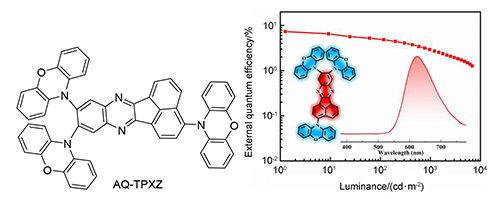摘要/Abstract

采用苊并[1,2-b]喹喔嗪(AQ)作为一种新的热活化延迟荧光(TADF)电子受体(A)基团,通过与强电子给体(D)基团吩噁嗪连接成D-A结构,合成出一种新型TADF分子10,10',10''-(苊并[1,2-b]喹喔嗪-3,9,10-三基)-三(10H-吩噁嗪)(AQ-TPXZ),该分子材料发射红色荧光.理论计算表明,该分子的轨道电子云重叠度很小.通过荧光和磷光光谱计算得出,其单线态-三线态能隙差为0.02 eV.瞬态衰减测试显示AQ-TPXZ具有瞬时寿命和延迟寿命两种组分.以AQ-TPXZ为发光材料的有机电致发光器件(OLED)实现了红光发射,峰值位于624 nm处.该器件的最大外量子效率为7.4%,高于传统的OLED的理论最大外量子效率(5%),这一结果不仅表明AQ-TPXZ为红光TADF分子,同时表明AQ可作为一种新的红光TADF电子受体片段.
关键词: 热活化延迟荧光, 苊并[1,2-b]喹喔嗪, 吩噁嗪, 红光发光分子, 有机发光器件
A new thermally activated delayed fluorescence (TADF) acceptor (A) segment, acenaphtho[1,2-b]quinoxaline (AQ) group, is designed. And a novel red TADF material 10,10',10''-(acenaphtho[1,2-b]quinoxaline-3,9,10-triyl)tris(10H-phenoxazine) (AQ-TPXZ) is developed by the conjunction of AQ group with phenoxazine as donor (D) moieties. The density functional theory calculation shows that this D-A molecule has a well separation between the highest occupied molecular orbital and the lowest unoccupied molecular orbital. And the energy splitting between the lowest singlet state and the lowest triplet state is calculated to be 0.02 eV. The transient photoluminescence decays of AQ-TPXZ doped 4,4'-di(9H-carbazol-9-yl)-1,1'-biphenyl film exhibit double-component emission decay profiles. The organic light-emitting diode (OLED) using AQ-TPXZ as dopant realizes red emission with a peak at 624 nm. Moreover, the device obtains maximum external quantum efficiency (EQE) up to 7.4%, which is higher than the theoretical maximum EQE (5%) of traditional fluorescent OLEDs. This result not only indicates that AQ-TPXZ is a red TADF material but also provides a newly electron acceptor segment for designing novel red TADF emitters.
Key words: thermally activated delayed fluorescent, acenaphtho[1,2-b]quinoxaline, phenoxazine, red emitter, organic light-emitting diode
PDF全文下载地址:
点我下载PDF
